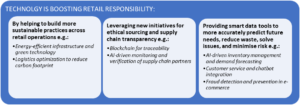In a relatively short space of time, technology has transformed the retail industry inside and out. The internet, cloud, connectivity, eCommerce, mobile, big data and analytics have led to new commerce and marketing channels and redefined retail supply, distribution and management.

Technical innovation has shortened buying cycles, globalized even the most niche markets, and prompted entirely new shopping trends and behaviors. Every retail function is enriched with a continuous stream of data, to build better practices, closer customer relations and more sophisticated targeting and personalization.
But, amid all the changes powered by high-tech disruption there is one constant – ensuring the safety and satisfaction of customers.
Despite its rapid evolution, technology remains an enabler not an end goal
Whether you’re an international retailer, a start-up eCommerce brand, manage physical outlets or provide retail solutions, it pays to remember that though tech is a powerful enabler, the end goal is the happiness of the customer. No matter how sophisticated or exciting the tech is, if consumer needs are forgotten along the path to innovation, then loyalty and sales will be lost.
To date, much of the emphasis for technology investment has been on lifting acceptance, conversion and sales by delivering a fast, seamless and secure purchase experience. But as consumer needs evolve there are other criteria that are becoming important.
Among these is a growing demand for greater sustainability, accountability and transparency – especially among the digital generation of consumers. According to the World Economic Forum, 75% of Gen Z now prioritize ethics over brand.
Consumers want to feel good about who they are buying from
As the public’s shopping lens increasingly focuses on environmental and ethical issues, they want their shopping experiences to be not just smooth but also ‘guilt free’. And they are prepared to back this up with their wallets.
Indeed, two thirds of consumers say they will pay more for sustainable products. Looking at Gen Z, who will represent 27% of consumers by 2031, almost 90% would spend an extra 10% or more.
It’s clear that those retailers committed to more responsible practices stand to benefit. The race is now on to embrace tech that also helps boost retailers’ sustainability credentials.
Today the innovation spotlight is not just on the customer, but also on communities and the planet and how new developments can help retailers contribute to the ‘circular economy’.
New technology is making retail more responsible
Technology is helping brands to take more control over their own operations, their suppliers and to navigate and reduce risk. According to Deloitte, 73% of Consumer Industry CXOs have increased investments in sustainability over the last year.
Here are just some of ways technology is powering more responsible commerce:

- Energy-efficient infrastructure including electronic inventory control systems, central databases, smart checkouts, and automated forecasting systems are now a must for any retailer looking to reduce overheads, improve planning, and create competitive edge.
- Similarly, green processing technology is heralding more sustainable manufacturing, and logistics optimization is reducing carbon footprints by making all parts of the value chain more efficient.
- Dynamic AI is now being actively incorporated into supply chain management to optimize delivery routes and schedules, adjusting them automatically to make better use of fuel, personnel and other resources.
- Blockchain is being used to aid ethical sourcing and make supply chains more traceable with data-driven monitoring and verification of partners and suppliers including records of waste and emissions and proof of authenticity.
- Meanwhile, new developments in AI and Machine Learning (ML) are harnessing real-time data to predict demands more accurately, allocate better use of resources, prevent over stocking and make supply, warehousing and distribution more efficient and less wasteful.
- Retailers are also adopting conversational AI to automate online customer services and drive interactive chatbots that speed service, flag and fast-fix issues and improve future experiences.
- AI is also instrumental in eCommerce fraud detection and prevention to monitor transaction flows, spot bad actors and new attack vectors and automatically update rules and safeguards to minimize risk while optimizing acceptance rates.
Digital transformation is helping retailers to be more customer-centric
Just as technology is transforming retail upstream, it is also revolutionizing customer engagement downstream, enhancing consumer experiences irrespective or market or channel. By 2026, retailers‘ global investments in digital transformation tools are expected to reach $388 billion, growing by 18% a year.

There is no shortage of customer facing use cases:
- ML-based data analytics systems are now widely adopted in marketing to recognize intent, aid product discover and to personalize the shopping experience with recommendation engines, curated content and targeted advertising. Retailers are also using it to optimize inventory management and set more flexible pricing strategies which can help reduce the cost of sustainable products to consumers.
- Able to mimic human learning and communication, AI-related cognitive technologies such as natural language processing (NLP), are being used to collect data and power interactive solutions like chatbots and contextual shopping leading to less friction and better engagement.
- A focus on cross channel integration has resulted in widespread availability of ultra-convenient hybrid omnichannel services like buy online pay in store (BOPIS), click-and-collect and same day-delivery. In some cases, these have resulted in brand new business models e.g. Deliveroo
- Retailers are making product discovery fun using Augmented Reality (AR) and Virtual Reality (VR) instore, online and in-app to enhance product visualization as in try-before-you-buy experiences and to aid in-store navigation and interactive displays. Two great examples are Sephora Virtual Artist which provides virtual makeovers and Ikea’s AR app that allows consumers to virtually view new products in their home. By 2025, it’s predicted that 76% of consumers will use AR as a practical tool in their daily lives.
- Pulling on innovation from multiple partners across multi-tech ecosystems is also transforming traditional retailing with concepts like smart shelves, endless aisle kiosks and checkout-free stores as well as remote automated ordering direct from smart devices.
Technology aids responsibility, but comes with its own challenges
The potential for new revenue, cost savings, and improved products and customer-centricity is a great motivation to adopt technology, but there’s also legal, ethical and risk issues that may arise regarding the collection, storage, and use of personal or sensitive data.
While retailers are paying closer attention to how they handle and protect user data, many are doing it solely to stay compliant with privacy regulations like the General Data Protection Regulation (GDPR) or the California Privacy Rights Act (CPRA).
But that may not be enough. Some customers remain sensitive about the use of their data and find too much personalization intrusive. How can retailers address this?
Here are three ways:
- Balance data-driven insights with consumer privacy concerns
Adopt best practice to balance the data needs of your business with the privacy needs of your customers. This includes obtaining consent and feedback prior to collecting and using data, limiting the scope and duration of data collection and use to what is necessary and relevant, protecting data from unauthorized access or modification, and respecting the rights and preferences of customers regarding their data.
- Ensure responsible use of AI and algorithms in decision-making
As AI algorithms continue to evolve and grow, so do the associated risks. Retail data scientists, system designers, and programmers must be able to address critical and legal questions when accountability for AI decisions is raised. Having a clear pathway for understanding the ethical position of organizations and their decision makers can help.
- Value and communicate your data protection and privacy policies
Companies that are committed to user privacy are less likely to experience a breach and will have greater consumer trust. Use Data Privacy Notices to provide transparency and accountability and show a clear commitment to protecting your customers’ personal information. In your policy be clear exactly how you handle consumer data and outline your plans for aligning with data protection regulations as they evolve.
Shopping experiences will become even more extraordinary (and responsible)
As technology continues to converge and evolve, it undoubtedly has the potential to deliver truly extraordinary and transformational experiences.
Looking to the future, shopping will become much more immersive. For instance, through embedded commerce which lets customers buy direct through social, entertainment and gaming platforms.
The roll out of 5G infrastructure and smart home gadgets will make the Internet of things a reality for normal consumers, driving new levels of convenience by automating the purchase of day-to-day necessities like groceries. Other tech developments like biometrics and tokenization are already gaining traction in making digital payments smooth and not disruptive to the overall shopping experience, further optimizing the journey for users.
And it won’t be long before shoppers’ avatars are regularly strolling through the metaverse as retailers exploit energy-efficient virtual spaces to host events and drive interactive and personalized experiences.
Technology will be a core driver of next generation retail growth
Making the right investments in next generation tech like green infrastructure, omnichannel technology, payments optimization, hybrid services, AI, ML and personalization, and multi-layered fraud methods now will ensure that retail businesses stay out in front and able to keep pace with constantly shifting consumer, legislative, economic and commercial requirements.
Not only that, but it will also be key to powering more profitable and responsible business models. By keeping retailers resource-lite and lean, it can make their operations more sustainable and help to offset negative environmental impacts. And that’s good news for everyone.
Conclusion
As technology continues to transform the retail industry, it’s important to remember that the heart of retail remains customer satisfaction. While technology offers incredible opportunities for efficiency, sustainability, and enhanced experiences, it’s crucial for retailers to strike a balance between innovation and responsibility.
By adopting technology responsibly and keeping customer needs at the forefront, retailers can not only thrive in the ever-evolving market but also contribute to a more sustainable and customer-centric future for the industry.
- SEO Powered Content & PR Distribution. Get Amplified Today.
- PlatoData.Network Vertical Generative Ai. Empower Yourself. Access Here.
- PlatoAiStream. Web3 Intelligence. Knowledge Amplified. Access Here.
- PlatoESG. Carbon, CleanTech, Energy, Environment, Solar, Waste Management. Access Here.
- PlatoHealth. Biotech and Clinical Trials Intelligence. Access Here.
- Source: https://blog.2checkout.com/how-technology-is-transforming-retail/



